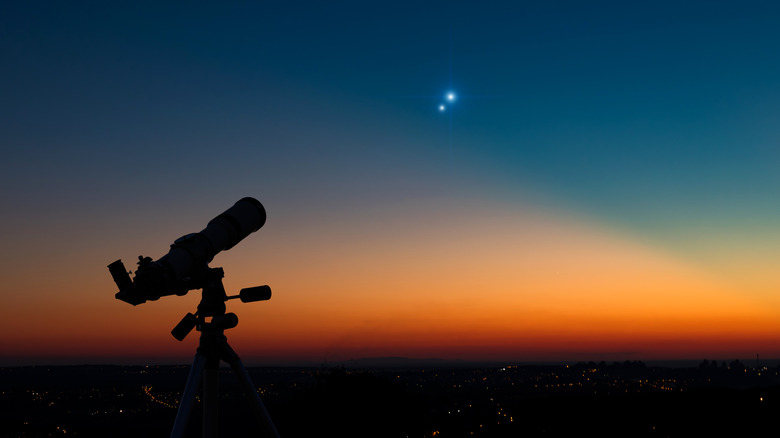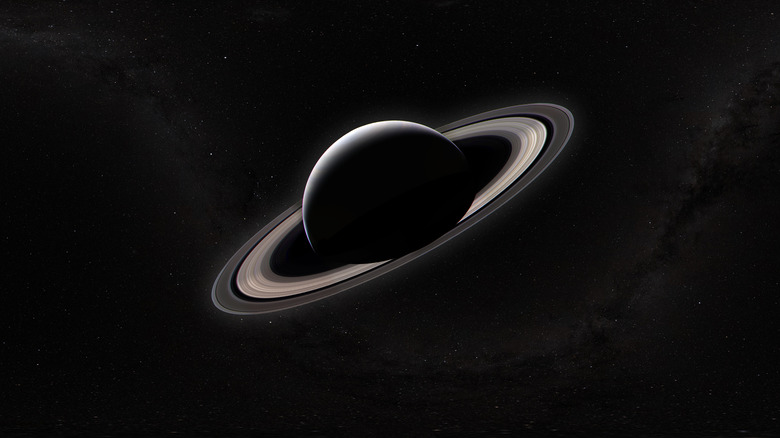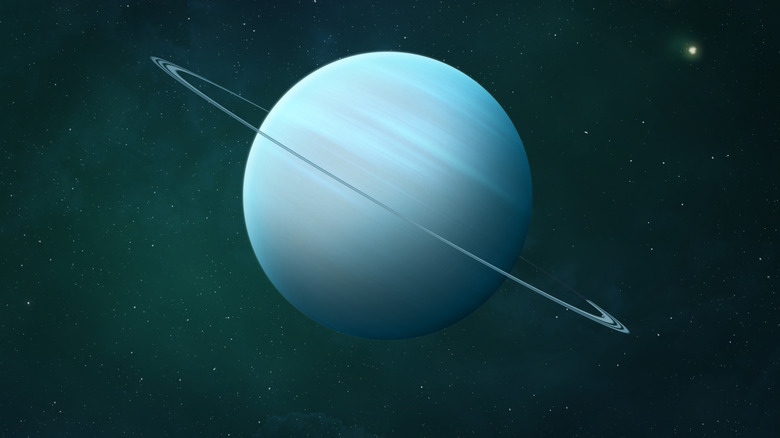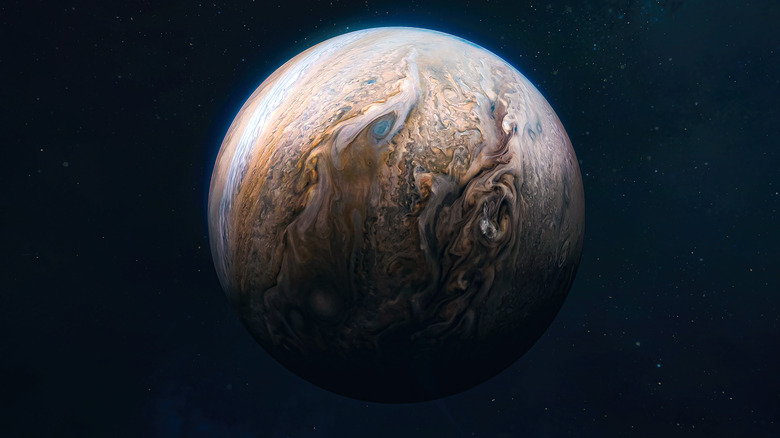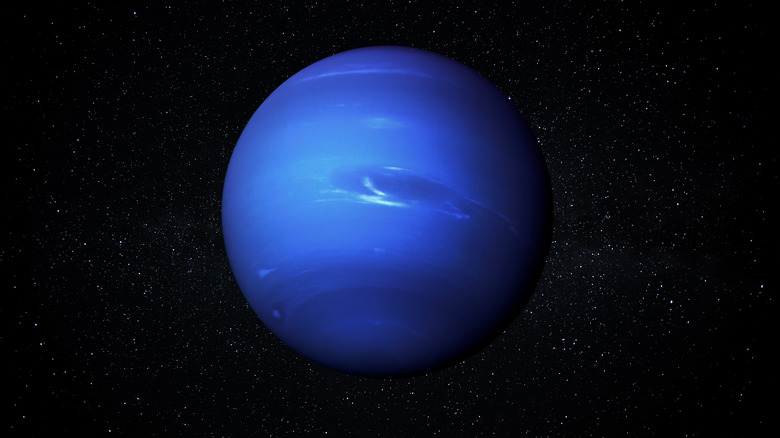The Surprising Thing These Four Planets Have In Common
For thousands of years, humans had only the vaguest understanding of the planets in the solar system. Indeed, to the ancients, the five visible planets (Mercury, Venus, Mars, Jupiter, and Saturn) appeared as stars — albeit stars that moved faster across the sky than others. It was this fast motion, relative to the rest of the visible universe, that gave rise to their name: as the Smithsonian National Air and Space Museum explains, the ancient Greeks called them "planetes," or "wanderers."
The invention of the telescope in the 17th century changed everything, however. Using this new tool, scientists were able to begin to plumb the depths of the planets' mysteries. And one particularly groundbreaking discovery was that one of those planets, Saturn, had rings. Centuries later, through the advancement of telescope technology as well as space exploration, science would learn that Saturn was not unique in having a ring system. All four of the outer, gas-giant planets — Jupiter, Saturn, Uranus, and Neptune — have rings.
Saturn's rings were discovered in 1610
According to NASA, Galileo discovered Saturn's rings in 1610. However, two problems plagued his discovery. First, due to the relative positions of Saturn, the sun, and Galileo's telescope on Earth, the rings appeared as simple bulges behind the planet. Indeed, a confused Galileo wrote that the planet had "ears." Second, due to the simplicity of his telescope, the astronomer couldn't discern that they were actually rings, and that there are more than one of them.
Galileo actually benefited from some good timing, too. As NDTV reports, because of Saturn's tilt, and its rotation around the sun relative to the earth, every 14.7 years the rings are effectively invisible to observers on Earth. That means, had Galileo used his telescope to study Saturn a few years earlier or a few years later, he wouldn't have seen the rings at all.
Just how many rings Saturn has is uncertain. For casual observers using a backyard telescope, it appears as if the planet has seven of them. However, according to a companion NASA report, spacecraft that have visited the planet have identified hundreds of rings, and there may be as many as a thousand of them.
Uranus' rings were discovered in 1977
Uranus, the seventh planet from the sun, claims two superlatives among the planets. It was the first planet outside the "original" five to be discovered, by Sir William Herschel in 1781 according to Space.com. It was also the first planet, other than Saturn, to have been found to have a ring system.
Specifically, as Britannica reports, American astronomer James L. Elliot and colleagues discovered the ring system using a telescope. As was the case with Galileo's discovery of Saturn's rings, Elliot benefitted from some fortuitous timing. In this case, the planet passed between Earth and a distant star, allowing Elliot and his team to determine that the planet was surrounded by five rings. Later observations, including a flyby of the Voyager 2 spacecraft, confirmed that Uranus actually has at least 13 rings and possibly many more, according to Physics Today.
The Voyager 2 spacecraft also found that the gravitational pull of two of Uranus' innermost moons, Cordelia and Ophelia, effectively "shepherd" one ring, maintaining its narrow width.
Jupiter's rings were discovered in 1979
Unlike the aforementioned planets, the discovery of Jupiter's ring system was made not by an astronomer on Earth using a telescope, but rather a machine hurtling through space. Specifically, as NASA explains, The Voyager 1 spacecraft flew to Jupiter and discovered that the planet has at least one ring. In order to get the view, the craft had to be positioned such that the planet was backlit by the sun (the rings can also be detected through infrared observation).
The Jovian rings, unlike those of its neighbor Saturn, which are composed at least partially of large chunks of ice and rock, Jupiter's are composed entirely of small dust particles.
The origin of the ring system was a mystery, at first, according to a companion NASA report. However, scientists later determined that they are created by asteroid impacts against certain Jovian moons, which vaporize dust and send it into orbit, to eventually be absorbed into the planet's ring system. Jupiter has four known rings, according to Universe Today.
Neptune's rings were discovered in 1984 (sort of)
Neptune was discovered in 1846, according to EarthSky, not by a telescope, but by mathematics. Indeed, several researchers, working independently, all worked out the existence of the planet, even though it couldn't be seen with a telescope, by observing the gravitational pull Neptune had on its neighbor, Uranus.
Half a century later, according to Universe Today, William Lassell claimed to have discovered a ring around Neptune, but his claim was never verified. Again in 1968, scientists found evidence of a ring, but weren't sure if it was complete. And in 1984, according to Harvard University, a Chilean team determined that Neptune had five rings. And finally, in 1989, the Voyager 2 spacecraft conclusively determined that Neptune has rings. They are believed to consist mostly of dust and small rocks.
According to NASA, Neptune has at least five main rings and four prominent ring arcs. Similar to at least one of the Uranus rings, scientists believe that a moon — in this case Neptune's Galatea — exerts enough gravitational pull on the arcs to give them stability.
